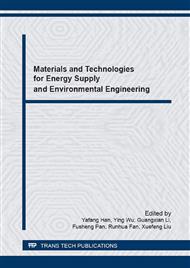[1]
Xu, D. -Y. & Yang, Z., Cross-linked tyrosinase aggregates for elimination of phenolic compounds from wastewater, Chemosphere. 92 (2013) 391-398.
DOI: 10.1016/j.chemosphere.2012.12.076
Google Scholar
[2]
Ashraf, H. & Husain, Q., Studies on bitter gourd peroxidase catalyzed removal of p-bromophenol from wastewater, Desalination. 262 (2010) 267-272.
DOI: 10.1016/j.desal.2010.05.044
Google Scholar
[3]
Yousef, R. I., El-Eswed, B. & Ala'a, H., Adsorption characteristics of natural zeolites as solid adsorbents for phenol removal from aqueous solutions: kinetics, mechanism, and thermodynamics studies, Chem. Eng. J. 171 (2011) 1143-1149.
DOI: 10.1016/j.cej.2011.05.012
Google Scholar
[4]
Lazo-Cannata, J. C. et al, Adsorption of phenol and nitrophenols by carbon nanospheres: Effect of pH and ionic strength, Sep. Purif. Technol. 80 (2011) 217-224.
DOI: 10.1016/j.seppur.2011.04.029
Google Scholar
[5]
Reis, M. T. A. et al, Removal of phenols from aqueous solutions by emulsion liquid membranes, J. Hazard. Mater. 192 (2011) 986-994.
Google Scholar
[6]
Zidi, C., Tayeb, R. & Dhahbi, M., Extraction of phenol from aqueous solutions by means of supported liquid membrane (MLS) containing tri-n-octyl phosphine oxide (TOPO), J. Hazard. Mater. 194 (2011) 62-68.
DOI: 10.1016/j.jhazmat.2011.07.071
Google Scholar
[7]
Zhu, X. et al, Scale-up of BDD anode system for electrochemical oxidation of phenol simulated wastewater in continuous mode, J. Hazard. Mater. 184 (2010) 493-498.
DOI: 10.1016/j.jhazmat.2010.08.062
Google Scholar
[8]
Jiang, P., Zhou, J., Zhang, A. & Zhong, Y., Electrochemical degradation of p-nitrophenol with different processes, J. Environ. Sci. 22 (2010) 500-506.
Google Scholar
[9]
Sun, X., Wang, C., Li, Y., Wang, W. & Wei, J., Treatment of phenolic wastewater by combined UF and NF/RO processes, Desalination. 355 (2015) 68-74.
DOI: 10.1016/j.desal.2014.10.018
Google Scholar
[10]
Li, L., Dai, W., Yu, P., Zhao, J. & Qu, Y., Decolorisation of synthetic dyes by crude laccase from Rigidoporus lignosus W1, J. Chem. Technol. Biotechnol. 84 (2009) 399-404.
DOI: 10.1002/jctb.2053
Google Scholar
[11]
Altikatoglu, M. & Basaran, Y., Additive effect of dextrans on the stability of horseradish peroxidase, Protein. J. 30 (2011) 84-90.
DOI: 10.1007/s10930-011-9306-4
Google Scholar
[12]
Wagner, M. & Nicell, J., Peroxidase-catalyzed removal of phenols from a petroleum refinery wastewater, Water. Sci. Technol. 43 (2001) 253-260.
DOI: 10.2166/wst.2001.0097
Google Scholar
[13]
Alemzadeh, I. & Nejati, S., Phenols removal by immobilized horseradish peroxidase, J. Hazard. Mater. 166 (2009) 1082-1086.
DOI: 10.1016/j.jhazmat.2008.12.026
Google Scholar
[14]
Wan, M. M., Lin, W. G., Gao, L., Gu, H. C. & Zhu, J. H., Promoting immobilization and catalytic activity of horseradish peroxidase on mesoporous silica through template micelles, J. Colloid. Interface. Sci. 377 (2012) 497-503.
DOI: 10.1016/j.jcis.2012.03.057
Google Scholar
[15]
Li, C., Zhou, L., Wang, C., Liu, X. & Liao, K., Electrospinning of a PMA-co-PAA/FP biopolymer nanofiber: enhanced capability for immobilized horseradish peroxidase and its consequence for p-nitrophenol disposal, RSC. Adv. 5 (2015) 41994-41998.
DOI: 10.1039/c5ra05626h
Google Scholar
[16]
Lei, Z. et al, Spheres-on-sphere silica microspheres as matrix for horseradish peroxidase immobilization and detection of hydrogen peroxide, RSC. Adv. 5 (2015) 38665-38672.
DOI: 10.1039/c5ra03755g
Google Scholar
[17]
Zhang, Y. et al, Synthesis of novel poly (N, N-diethylacrylamide-co-acrylic acid)(P (DEA-co-AA) microgels as carrier of horseradish peroxidase immobilization for pollution treatment, Macromol. Res. 20 (2012) 484-489.
DOI: 10.1007/s13233-012-0044-z
Google Scholar
[18]
Akter, R., Rahman, M. A. & Rhee, C. K., Amplified electrochemical detection of a cancer biomarker by enhanced precipitation using horseradish peroxidase attached on carbon nanotubes, Anal. Chem. 84 (2012) 6407-6415.
DOI: 10.1021/ac300110n
Google Scholar
[19]
Zhang, F. et al, Horseradish peroxidase immobilized on graphene oxide: physical properties and applications in phenolic compound removal, J. Phys. Chem. C. 114 (2010) 8469-8473.
DOI: 10.1021/jp101073b
Google Scholar
[20]
Luo, L. et al, Hydrogen peroxide biosensor based on horseradish peroxidase immobilized on chitosan-wrapped NiFe2O4 nanoparticles, Mikrochim. Acta. 174 (2011) 55-61.
DOI: 10.1007/s00604-011-0591-6
Google Scholar
[21]
Mezohegyi, G., van der Zee, F. P., Font, J., Fortuny, A. & Fabregat, A., Towards advanced aqueous dye removal processes: A short review on the versatile role of activated carbon, J. Environ. Manage. 102 (2012) 148-164.
DOI: 10.1016/j.jenvman.2012.02.021
Google Scholar
[22]
Schulte-Ladbeck, R., Kolla, P. & Karst, U., A field test for the detection of peroxide-based explosives, Analyst. 127 (2002) 1152-1154.
DOI: 10.1039/b206673b
Google Scholar
[23]
German, D. P., Marcelo, K. R., Stone, M. M. & Allison, S. D., The Michaelis–Menten kinetics of soil extracellular enzymes in response to temperature: a cross-latitudinal study, Glob. Chang. Biol. 18 (2012) 1468-1479.
DOI: 10.1111/j.1365-2486.2011.02615.x
Google Scholar
[24]
Gao, X., Yu, K. K., Tam, K. Y. & Tsang, S. C., Colloidal stable silica encapsulated nano-magnetic composite as a novel bio-catalyst carrier, Chem. Commun. (2003) 2998-2999.
Google Scholar
[25]
Kim, J., Grate, J. W. & Wang, P., Nanostructures for enzyme stabilization, Chem. Eng. Sci. 61 (2006) 1017-1026.
Google Scholar
[26]
Takahashi, H. et al, Catalytic activity in organic solvents and stability of immobilized enzymes depend on the pore size and surface characteristics of mesoporous silica, Chem. Mater. 12 (2000) 3301-3305.
DOI: 10.1021/cm000487a
Google Scholar
[27]
Wang, Z. -G., Wan, L. -S., Liu, Z. -M., Huang, X. -J. & Xu, Z. -K., Enzyme immobilization on electrospun polymer nanofibers: an overview, J. Mol. Catal. B. Enzym. 56 (2009) 189-195.
Google Scholar
[28]
Zhai, R. et al, Chitosan–halloysite hybrid-nanotubes: Horseradish peroxidase immobilization and applications in phenol removal, Chem. Eng. J. 214 (2013) 304-309.
DOI: 10.1016/j.cej.2012.10.073
Google Scholar
[29]
Sović, D., Gajović, A. & Iveković, D., Bioelectrocatalytic and biosensing properties of horseradish peroxidase covalently immobilized on (3-aminopropyl)trimethoxysilane-modified titanate nanotubes, Electrochim. Acta. 56 (2011) 9953-9960.
DOI: 10.1016/j.electacta.2011.08.077
Google Scholar
[30]
Cheng, W. & Harper, W. F., Jr., Chemical kinetics and interactions involved in horseradish peroxidase-mediated oxidative polymerization of phenolic compounds, Enzyme. Microb. Technol. 50 (2012) 204-208.
DOI: 10.1016/j.enzmictec.2011.12.005
Google Scholar
[31]
Secula, M., Suditu, G., Poulios, I., Cojocaru, C. & Cretescu, I., Response surface optimization of the photocatalytic decolorization of a simulated dyestuff effluent, Chem. Eng. J. 141 (2008) 18-26.
DOI: 10.1016/j.cej.2007.10.003
Google Scholar
[32]
Calvino-Casilda, V., López-Peinado, A., Durán-Valle, C. & Martín-Aranda, R., Last decade of research on activated carbons as catalytic support in chemical processes, Catal. Rev. 52 (2010) 325-380.
DOI: 10.1080/01614940.2010.498748
Google Scholar


